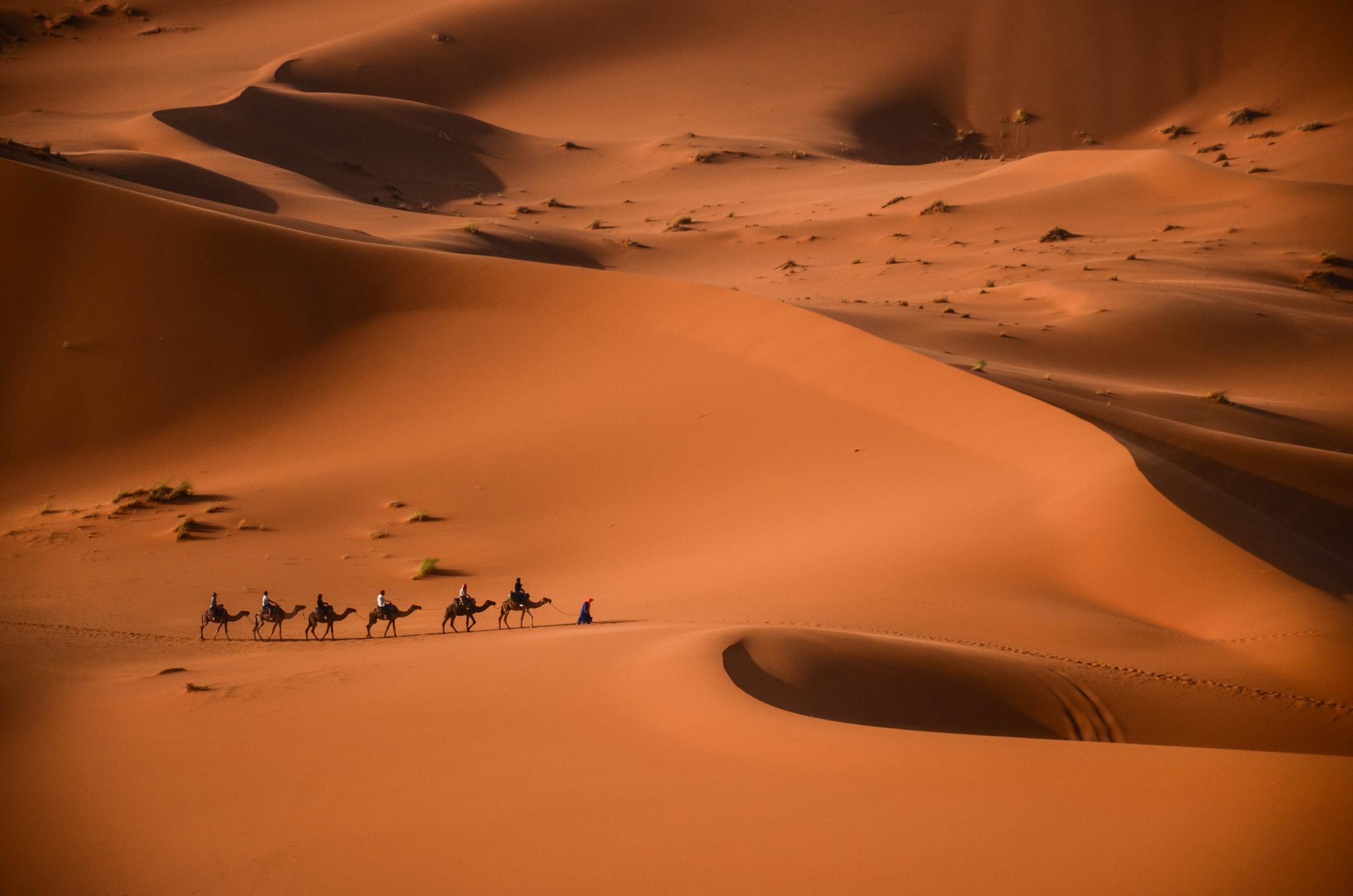The Sahara is the largest hot desert in the world, stretching for more than 3,000 miles across North Africa. Despite - or perhaps because of - its inhospitable landscape, it attracts scores of adventurers every year. It’s because of the vastness of the landscape, the shifting fluidity of golden dunes.
“I have always loved the desert. One sits down on a desert sand dune, sees nothing, hears nothing. Yet through the silence something throbs, and gleams,” Antoine de Saint-Exupéry writes, summing up its appeal.
In Morocco, the Sahara Desert is located along the southern border with Algeria, south of the Atlas Mountains. Once you’ve crossed over the mountains, you’ll reach the fortified city of Ouarzazate, considered the gateway to the Sahara. From here, you’ll pass across miles of barren gravel desert (known as ‘regs’), speckled with small desert oases and bare rocky plateaus known as hamadas.

Most travellers end up in one of the two largest dune fields of the Moroccan Sahara, Erg Chebbi or Erg Chigaga. They best correspond with our mental image of the desert - golden dunes that undulate towards the horizon, changing shape with the wind. It’s here you can trek with camels or spend a night under the stars in a Berber campsite.
In this adventure guide to Morocco’s Sahara Desert, we discuss some of the best activities to try, how to reach the desert and when to visit. It is intended to inspire, rather than instruct, and is no substitute for a decent map and the services of an experienced local guide.
Where is the Sahara Desert?
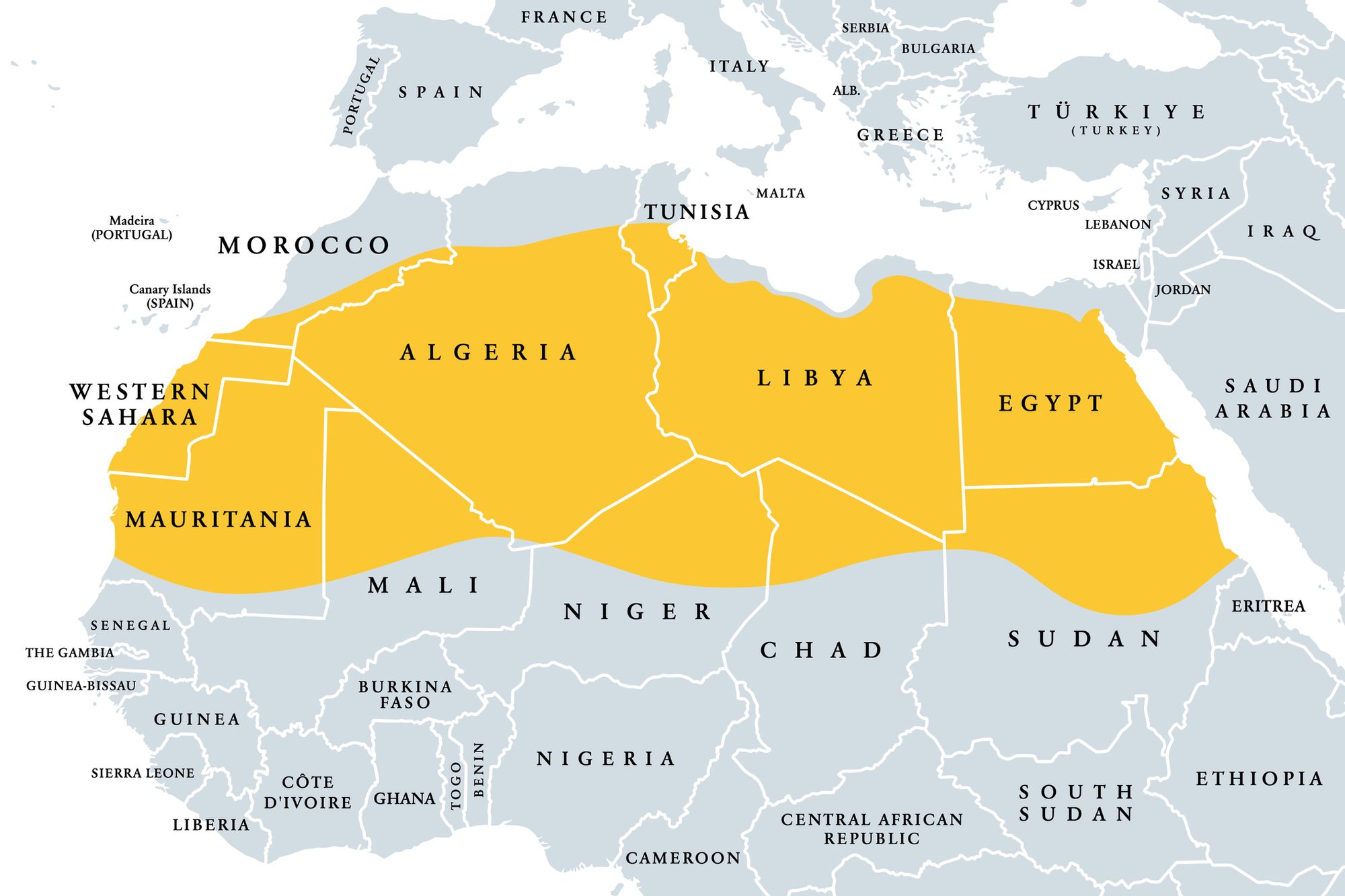
The Sahara Desert is the largest hot desert in the world. It measures approximately 3,000 miles from east to west and between 800 to 1,200 miles from north to south. It passes through 11 African countries: Algeria, Chad, Egypt, Libya, Mali, Mauritania, Morocco Niger, Western Sahara, Sudan, and Tunisia.
The boundaries of the Sahara are often roughly cited as the Atlantic Ocean in the west, the Atlas Mountains and the Mediterranean Sea in the north, the Red Sea in the east, and the valley of the Niger River in the south. However, unlike the borders of a country, the limits of a desert aren’t fixed. This is because a desert is defined by low average annual rainfall – usually 100 millimetres of rain per year or less. According to this metric, the limits of the Sahara Desert fluctuate between the wet and dry seasons. Climate change also affects rainfall patterns - scientists recently discovered that the summer limits of the Sahara have expanded up to 16% in the past century.
However, when people refer to the Sahara Desert in Morocco, they tend to mean the two main sand dune systems in the country, Erg Chebbi and Erg Chigaga. The closest town to Erg Chebbi is Merzouga, around 341 miles (550km) to the south east of Marrakech. Erg Chigaga is located to the south west of Erg Chebbi, close to the Algerian border. It’s a less established tourist destination; it’s quieter and remoter than Erg Chebbi. Once you’ve reached the gateway town of M’Hamid you’ll need to travel around 28 miles (45km) along an unmarked former caravan trail by 4x4 or off-road motorbike to reach it.
5 of the Best Things to Do in the Sahara Desert
1. Take a Camel Trek

Camel trekking is one of the most popular types of Sahara Desert tour, the ultimate form of slow travel across the desert. You’ll gain an insight into the nomadic way of life as you make your way over the undulating dunes on the back of one of these remarkable animals.

One of the most popular places to ride a camel in the Sahara is the Erg Chebbi dunes. We’d recommend travelling with a responsible tour operator, as it will help ensure that the animals you ride are well treated. An overnight expedition is better for the camels than a day trip, as it means they have the evening to recover.
2. Spend the Night in a Sahara Desert Camp
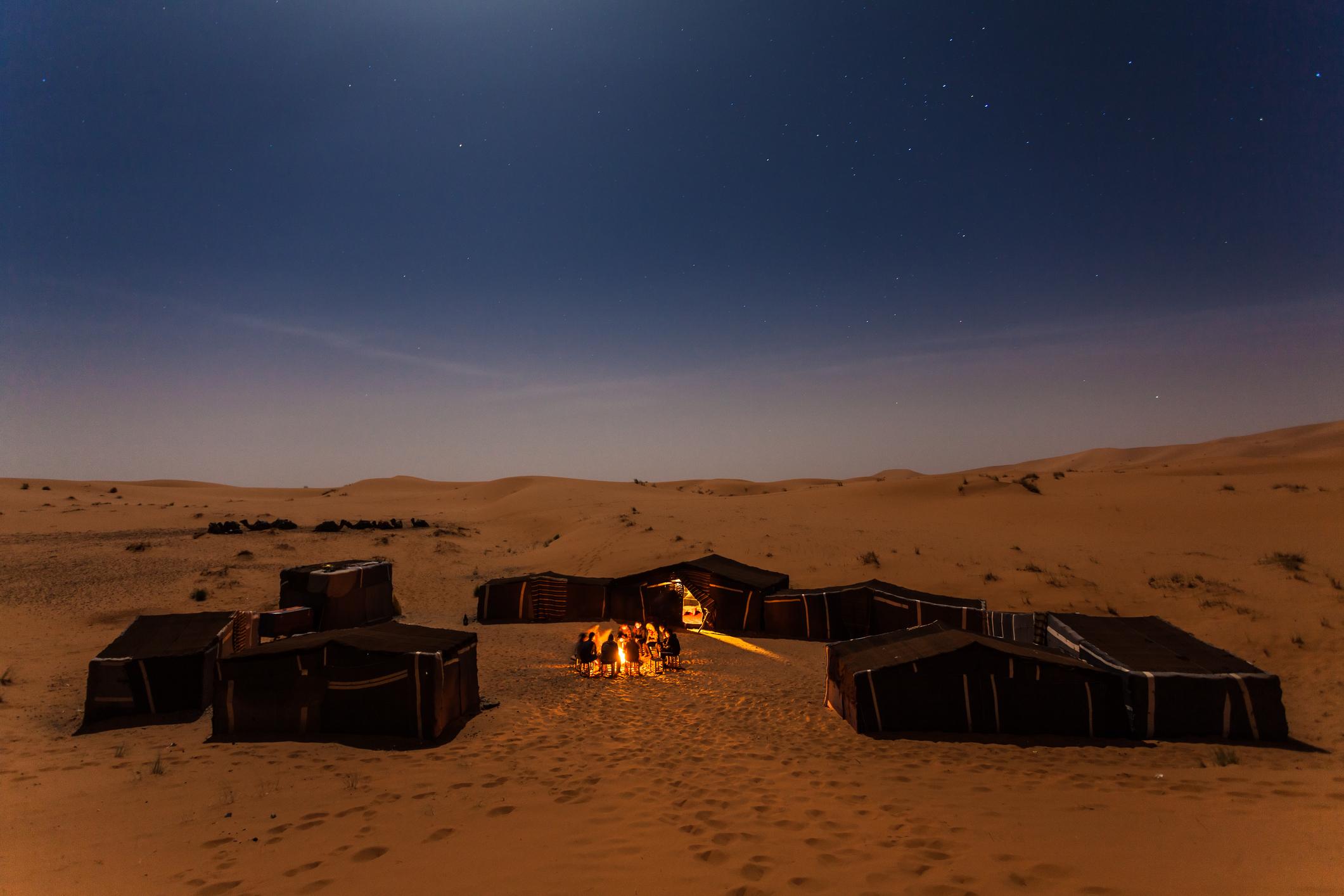
To really experience the desert, we recommend staying overnight in it. The Sahara Desert camps in Morocco are often run by Berber families, and will give you a taste of the hospitality and culture of these semi-nomadic people. You’ll sleep in luxurious, carpeted tents, and enjoy communal meals and cups of mint tea.
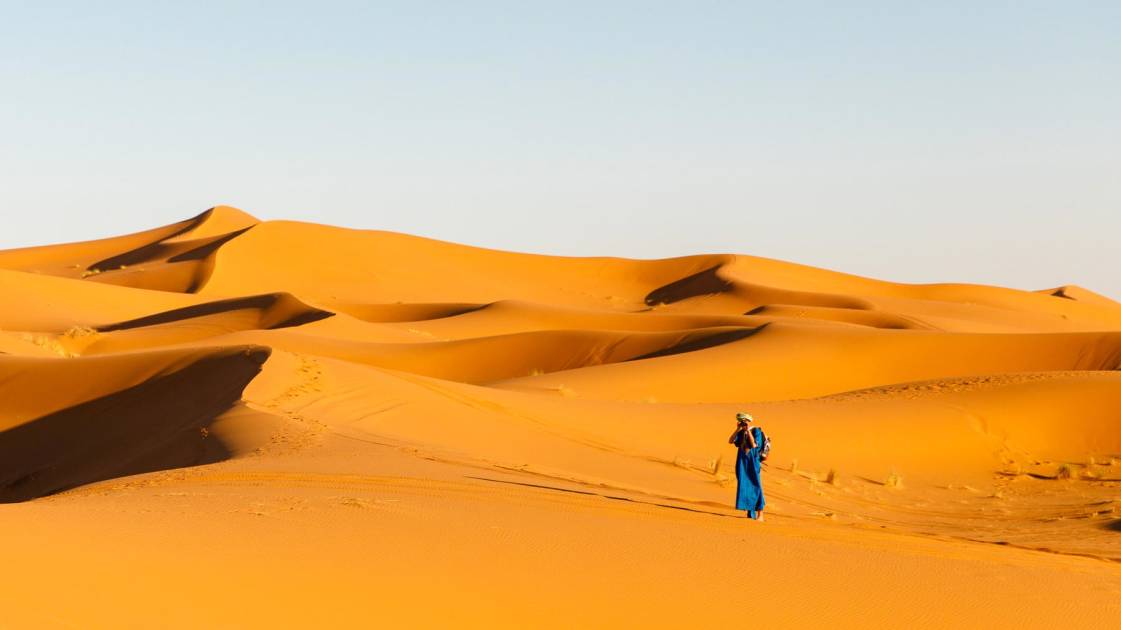
One of the best things about this experience is being able to experience the desert’s many transformations. You’ll see the dunes turn orange in the setting sun, and watch them darken to purple as the stars come out.
3. Pass Through the Sahara on a Cycle Tour
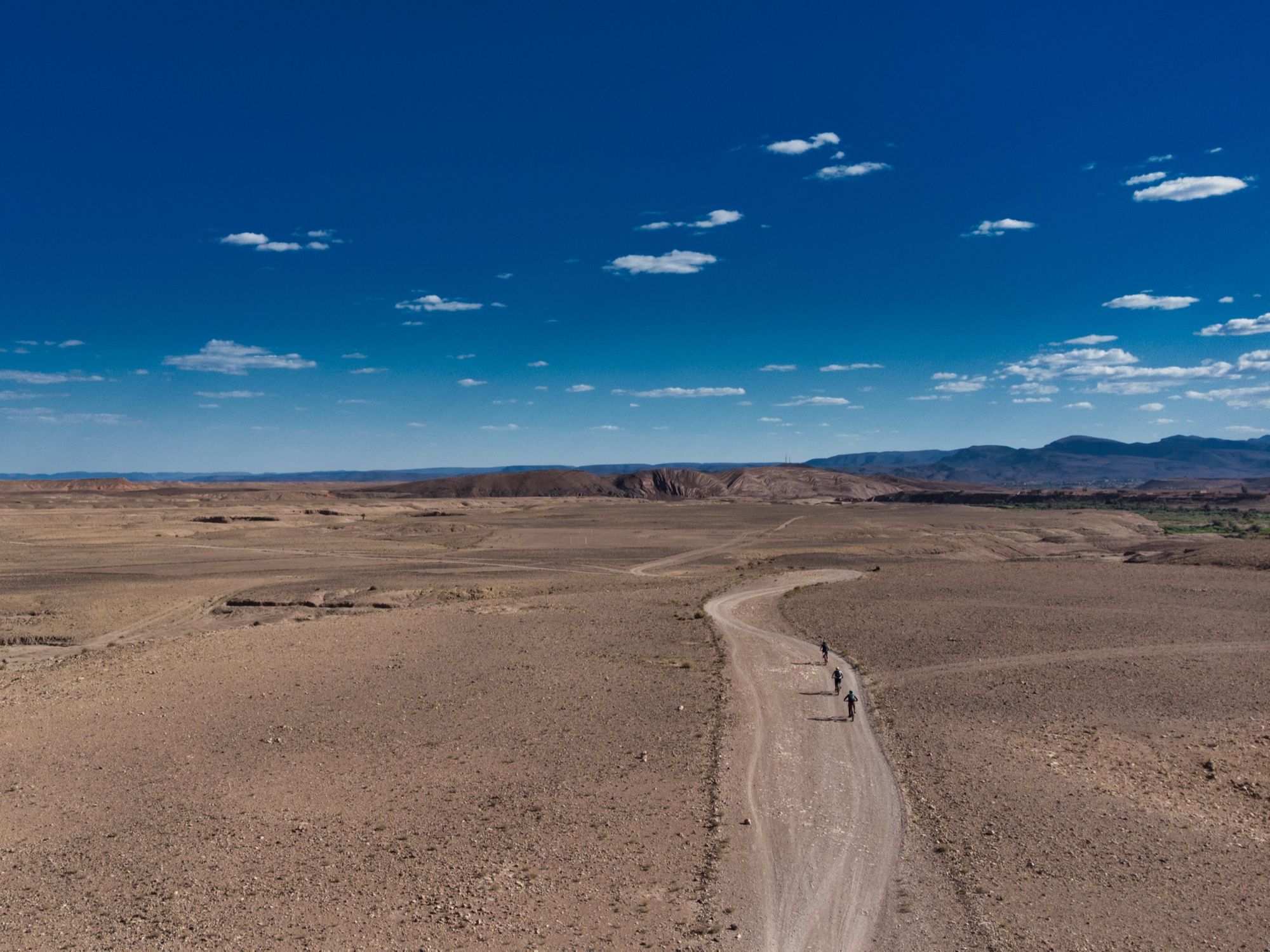
Morocco is a popular destination for both road cyclists and bikepackers, as over a short distance you can pass through a diverse series of landscapes, from mountains to desert. We would recommend that you cycle the Sahara with an experienced guide, as they have expert local knowledge of this unique environment.
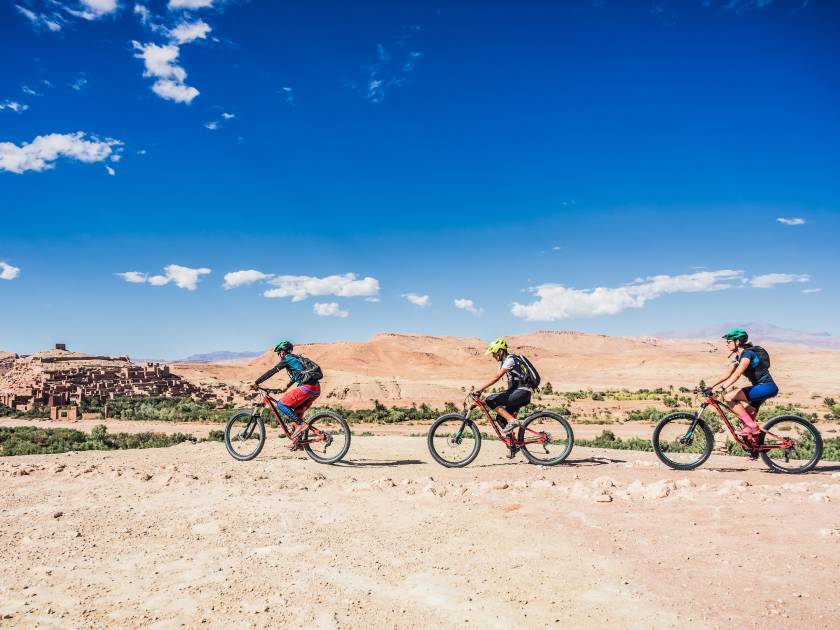
There are a number of different multi-day cycling routes in Morocco. A popular one is to pedal over the Tizi n’Tichka pass in the High Atlas and descend into the outer reaches of the Sahara. Visit the fortified city of Ait Ben Haddou, and ride through the Dades Valley via the Tizi n’Tazazert pass (2200m). You’ll cruise downhill through the lunar-like Saharan landscape. Spend the night at the Berber oasis town of N’kob, and from there you can cycle down sandy tracks to the desert.
4. Go Sandboarding in the Sahara
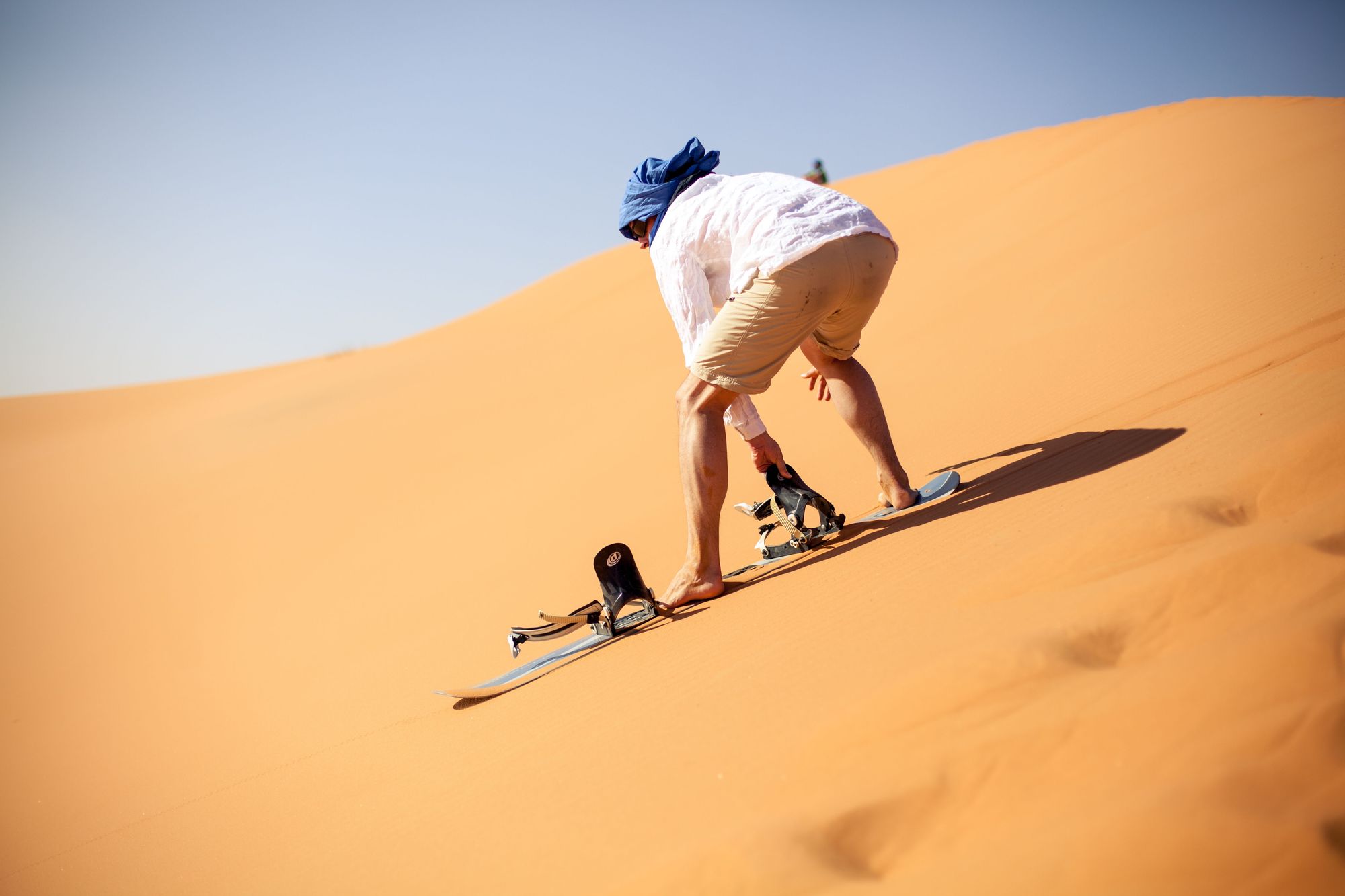
It’s very much like snowboarding except you exchange the white, cold powdery stuff for warm, yellow powdery stuff. Strap the board to your feet and enjoy the exhilarating glide down an undulating sand dune. If you’re feeling less confident, you can sit or lie on the board.

Popular spots for sandboarding in the Moroccan Sahara Desert are the Erg Chebbi dunes and the Erg Chigaga dunes. The Tifnit Dunes - near the coastal village of Tifnit - are another.
5. Go Rock Climbing in the Todra Gorge
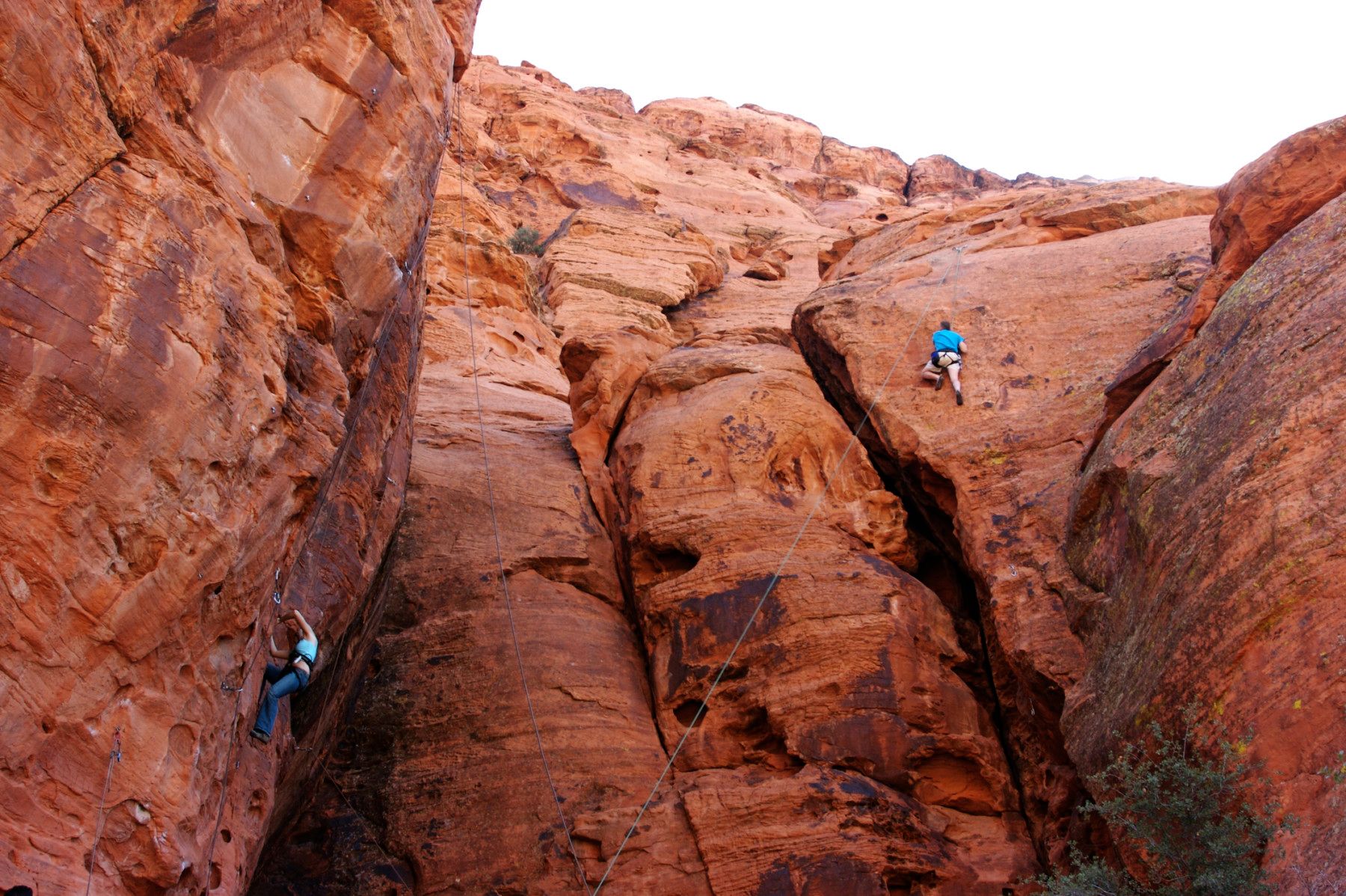
The red sandstone cliffs rise of the Todra Gorge rise up to 400 metres on either side of the Todra River, which carves a path through it. The gorge is the most popular spot in Morocco for rock climbing, with over 100 official routes for beginners to more advanced climbers.
We’d strongly recommend you go rock climbing in the Todra Gorge with an experienced instructor. They’ll provide you with safety equipment and advice - and they’ll be able to show you the best routes for your skill level.

Where to Stay in the Sahara Desert
If you’re visiting the desert in Morocco, there are several villages where you can base yourself. In this section, we’ll discuss the different ‘gateway towns’ for exploring the Sahara, as well as accommodation options within the desert itself.
Ouarzazate
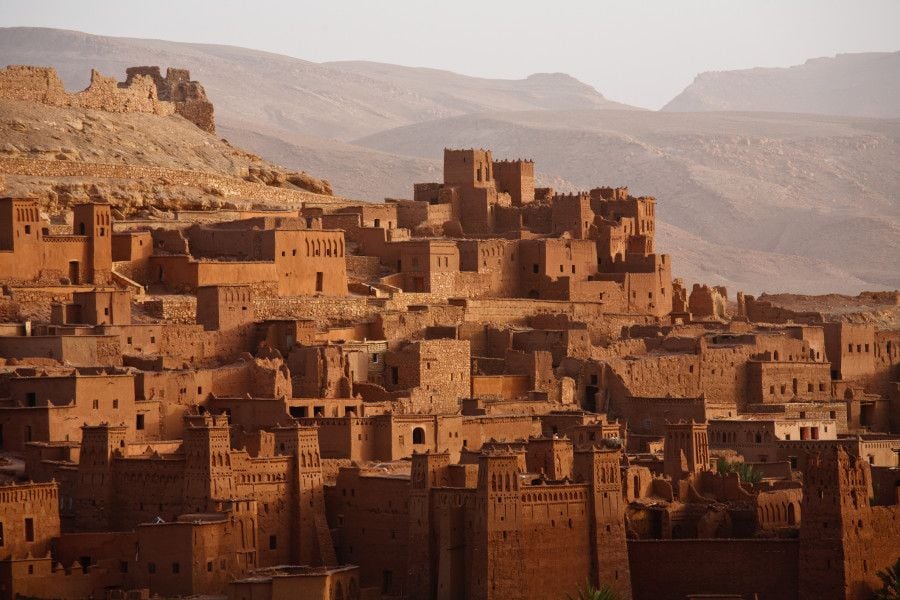
Nicknamed ‘the Door to the Desert’, Ouarzazate is located on a bare plateau south of the Atlas Mountains. It gained importance as a stopping-off point for Saharan caravan trade routes coming up from Africa, and has a fascinating cultural heritage due to the many different tribes who passed through it. It’s now a thriving urban centre, and a noted film-making location for Hollywood hits such as The Mummy and Gladiator.

Visit Ouarzazate en route from the Atlas Mountains to the Sahara. Explore the region’s many kasbahs (fortified complexes made of adobe) on a trip into the Dadès Valley, also known as ‘The Valley of a Thousand Kasbahs’. One of the best preserved is the UNESCO-designated Ait Ben Haddou. Another day trip option is to head to Fint Oasis, just 7.5 miles (12km) outside of Ouarzazate, a green oasis in the heart of the desert surrounded by four local villages.
Merzouga (Erg Chebbi)

Merzouga is a small village near the Algerian border, perched right on the edge of Erg Chebbi - the dunes are visible from the village. This is where most travellers come to arrange activities ranging from camel trekking to sandboarding. There’s accommodation in the village, but most people prefer to stay in the tented camps on the dunes themselves. These range from the luxurious to more traditional, family-run Berber tent accommodation - we recommend the latter.
M'Hamid (Erg Chigaga)
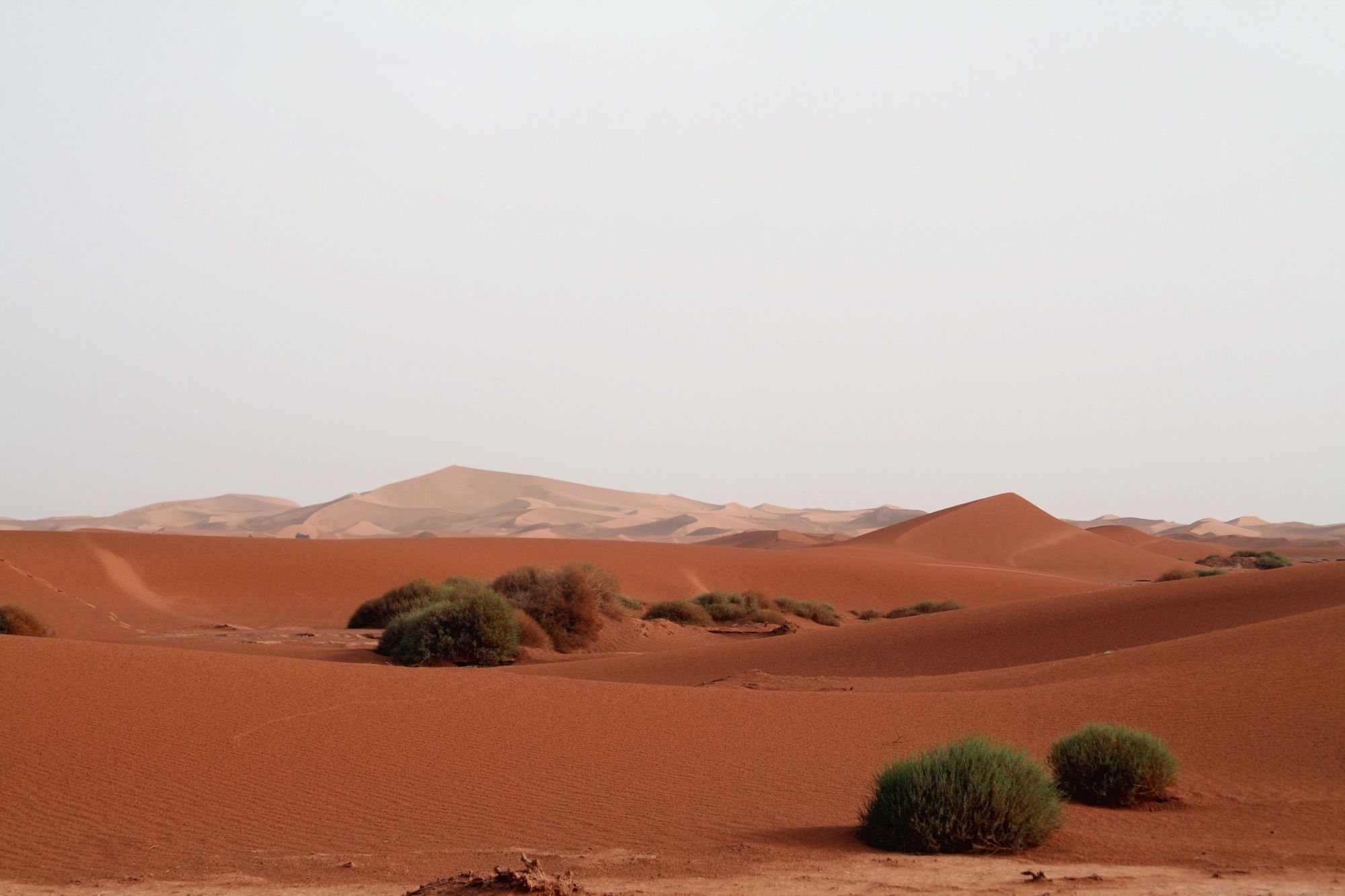
M’Hamid is the ‘end of the road’, the last outpost before the Sahara Desert really begins. It’s the town that travellers head to when they want to make an expedition to Erg Chigaga dunes - around 45 minutes away by off-road vehicle. It sees fewer visitors than Merzouga, and is therefore less touristy. However, there are a variety of accommodation options, from authentic local dars to tented camps.
When to Visit the Sahara Desert

The Sahara Desert can be visited year-round - each season comes with its own benefits. Spring (March to May) is considered one of the best times to visit, thanks to the comfortable weather. Daytime temperatures range from 22°C to 28°C, while nights average between 10°C to 15°C. Vegetation in the desert oases blooms, and clear skies make it an ideal time for stargazing. However, this is also one of the busiest times of year in the Sahara.
In summer (June to August), temperatures can soar to 45°C (with night time lows around 30°C), so it’s not for the faint of heart. Some tours - such as horse riding - won’t be operating. However, it’s one of the quietest times of year to visit. Autumn (September to November) is milder, with daytime temperatures ranging from 25°C to 28°C (nights range from 15°C to 20°C). This is also one of the quieter times to visit Morocco in general, as people will have returned to work and school after the summer break.
Winter, from December to February, is relatively warm during the day (18°C to 24°C) but can drop down as low as 5°C at night. But don’t let this put you off - sipping mint tea round a roaring campfire is an experience in itself.

What to Wear in the Sahara Desert, Morocco
It can get very hot in the desert, especially during the summer months. We recommend dressing in light coloured clothing, to reflect the sun’s rays. Wear full-length trousers or capris in a lightweight fabric, and loose fitting long-sleeved tops (a linen shirt is ideal). If you’re hiking, make sure you wear moisture wicking socks and breathable hiking boots or shoes. Sun protection is also necessary - bring sunglasses and a sun hat.
The desert can also get cold, especially on winter nights. Bring warmer clothes - such as a merino base layer and a lightweight down jacket - for chillier evenings at camp.
Inspired? Explore our Morocco tours, many of which visit the Sahara Desert.


